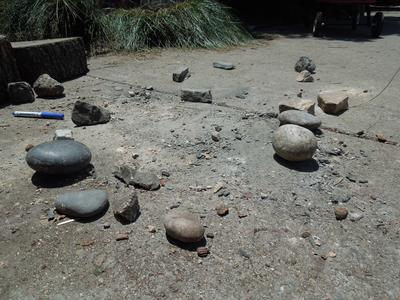Rocks and Sticks
Rock Crushing Remnants
Materials
Hammers
Knives
Rocks
Safety Glasses
Sticks
Twine
methods
Provide the time, space, and safety specifications for children to explore rocks and sticks.
Notes
Photos and stories here are from a preschool garden and Outside School, for school-age children.
Children became interested in rocks and sticks- their colors, textures, and types.
I had previously noted that we could use sharp rocks for cutting when we couldn't find scissors nearby, leading me back to my roots as an anthropology major and learning about ancient stone tools.
Look for rocks and sticks locally for collecting or purchasing (sometimes bundles of willow or birch sticks are available as home accents). Consider whether permits or permission is required for collecting. Soil stores such as American Soil and Stone in the San Francisco Bay Area offer grants to public schools and free rock trimmings for all. Develop a relationship with resources such as this.
Rocks and sticks are normal tools for play and learning and should be freely available. Safety rules around the preschool garden are that rocks cannot be thrown or dropped, and must be placed down gently (largely developed because young children have a hard time knowing the unpredictable movements of their peers and we want to minimize accidents). The consequence of not following those rules is that the child may not play with rocks again until their next visit. They remember quickly!
At Outside School, children make up rules as necessary about sticks and rocks. Our only steadfast rules are that when anyone says, “No,” or, “Stop,” that those words are always and immediately respected.
A fantastic California resource for local/traditional use of rocks as tools is the UC Davis Anthropology Department. Information I collected about their outreach programs can be found at their site.
International Stonework Play Day hosts an annual, worldwide date to create with stones and share stories.
Our group collected loose rocks on trails without removing them from the park for the month leading up to the day. Even a few sure adds to the weight of our packs! We kept them in a bandana and had our festivities atop boulders at a favorite location.
Using a sharp piece of rock to cut a plant leaf. This child promptly went to teach his new skill to another teacher!
“Rock Fort"
"Eggs for sale!" (Small on the left, large on the right.) Rocks offer infinite play possibilities!
Stronger than strong! These children found a way to move the rocks they wanted. Adults usually underestimate children's strength, stamina, determination, and ability to work together. Resist the urge to get involved!!!
A creation from International Stonework Play Day. The child who created this spent a really long time, taking into account advice from peers, to create this tripod. He was so happy with the result of his persistence!
Another International Stonework Play Day creation: "A sun with a snowman melting in the middle of it."
Beautiful birch branches always fall off in the wind, and I enjoy tying them in bundles to leave as art and play supplies.
Rocks, sticks, and shells categorized and displayed in a redwood burlwood vessel, ready for children to explore.
Class project using bamboo and other sticks lashed together and carried from garden to classroom as a group.
Whittling.
Ready for battle!
Lesson plan by Heather Taylor, teachoutside@gmail.com. You are welcome to share all materials with credit to her.













